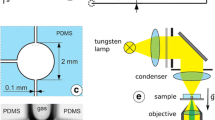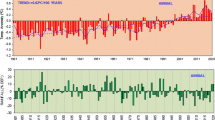Abstract
In this work, an experimental investigation of the single- and multiphase flows of two sets of fluids, CO2–ethanol and CO2–methanol, in a non-adiabatic microfluidic T-junction is presented. The operating conditions ranged from 7 to 18 MPa, and from 294 to 474 K. The feed mass fraction of CO2 in the mixtures was 0.95 and 0.87, respectively. Under these operating conditions, CO2 was either in liquid, gas or supercritical state; and the mixtures experienced a miscible single phase or a vapour–liquid equilibrium (VLE), with two separated phases. Taylor, annular and wavy were the two-phase flow regimes obtained in the VLE region. In the single phase region, the observed flows were classified into standard single-phase flows, “pseudo” two-phase flows and local phenomena in the T-junction. Flow regime maps were generated, based on temperature and pressure conditions. Two-phase flow void fractions and several parameters of Taylor flow were analysed. They showed a clear dependency on temperature, but were mostly insensitive to pressure. A continuous accumulation of liquid, either in the CO2 channel or at the CO2-side wall after the T-junction, disturbed most of the experiments in VLE conditions by randomly generating liquid plugs. This phenomenon is analysed, and capillary and wetting effects due to local Marangoni stresses are suggested as possible causes.












Similar content being viewed by others
Abbreviations
- C :
-
Correlation parameter (–)
- G d :
-
Vaporized mass diffusion fraction (–)
- N :
-
Number of liquid plugs (–)
- P :
-
Pressure (MPa)
- R :
-
Pixel resolution of images (pixel m−1)
- T :
-
Temperature (K)
- % v/v :
-
Volumetric fraction (–)
- \(\Updelta {\rm px}\) :
-
Difference in pixel position between two frames (pixel)
- d h :
-
Hydraulic diameter of the channel (m)
- f :
-
Frequency (Hz)
- fr:
-
Camera frame rate (Hz)
- t :
-
Time (s)
- u :
-
Velocity (m s−1)
- x :
-
Mass fraction in liquid phase (–)
- x o :
-
Mass fraction in mixture (–)
- y :
-
Mass fraction in vapour phase (–)
- ρ:
-
Density (kg m−3)
- θ:
-
Elongation rate (–)
- ɛ:
-
Void fraction (–)
- bn:
-
Bubble nose
- bub:
-
Bubble point
- bt:
-
Bubble tail
- dew:
-
Dew point
- exp:
-
Experimental
- hom:
-
Homogeneous
- l:
-
Liquid phase
- lp:
-
Liquid plug
- o:
-
Syringe pump conditions
- rel:
-
Relative
- v:
-
Vapour phase
- xio:
-
Xiong and Chung (2007)
- CO2 :
-
Carbon dioxide
- EtOH:
-
Ethanol
- MeOH:
-
Methanol
- VLE:
-
Vapour–liquid equilibrium
References
Agostini B, Revellin R, Thome JR (2008) Elongated bubbles in microchannels. Part I: Experimental study and modeling of elongated bubble velocity. Int J Multiph Flow 34(6):590–601
Akbar MK, Plummer DA, Ghiaasiaan SM (2003) On gas–liquid two-phase flow regimes in microchannels. Int J Multiph Flow 29(5):855–865
Ali MI, Sadatomi M, Kawaji M (1993) Adiabatic two-phase flow in narrow channels between two flat plates. Can J Chem Eng 71(5):657–666
Ambrosini W (2007) On the analogies in the dynamic behaviour of heated channels with boiling and supercritical fluids. Nucl Eng Des 237(11):1164–1174
Armand AA (1946) The resistance during the movement of a two-phase system in horizontal pipes. Izv Vses Teplotekh Inst 1:16–23 (A.E.R.E. Lib/Trans 828)
Bezanehtak K, Combes GB, Dehghani F, Foster NR, Tomasko DL (2002) Vapor–liquid equilibrium for binary systems of carbon dioxide + methanol, hydrogen + methanol, and hydrogen + carbon dioxide at high pressures. J Chem Eng Data 47(2):161–168
Brunner E, Hültenschmidt W, Schlichthärle G (1987) Fluid mixtures at high pressures IV. Isothermal phase equilibria in binary mixtures consisting of (methanol + hydrogen or nitrogen or methane or carbon monoxide or carbon dioxide). J Chem Thermodyn 19(3):273–291
Chehroudi B (2006) Supercritical fluids: nanotechnology and select emerging applications. Combust Sci Technol 178(1):555–621
Cheng L, Ribatski G, Thome JR (2008) Analysis of supercritical CO2 cooling in macro- and micro-channels. Int J Refrig 31(8):1301–1316
Chester TL (2004) Determination of pressure-temperature coordinates of liquid–vapor critical loci by supercritical fluid flow injection analysis. J Chromatogr A 1037(1–2):393–403
Chung PMY, Kawaji M (2004) The effect of channel diameter on adiabatic two-phase flow characteristics in microchannels. Int JMultiph Flow 30(7–8):735–761
Collier JG, Thome JR (1996) Convective Boiling and Condensation, 3rd edn. Oxford University Press, USA
Dang C, Iino K, Hihara E (2008) Study on two-phase flow pattern of supercritical carbon dioxide with entrained PAG-type lubricating oil in a gas cooler. Int J Refrig 31(7):1265–1272
Dreyfus R, Tabeling P, Willaime H (2003) Ordered and disordered patterns in two-phase flows in microchannels. Phys Rev Lett 90(14):144505
Galicia-Luna LA, Ortega-Rodriguez A, Richon D (2000) New apparatus for the fast determination of high-pressure vapor–liquid equilibria of mixtures and of accurate critical pressures. J Chem Eng Data 45(2):265–271
Garstecki P, Fuerstman MJ, Stone HA, Whitesides GM (2006) Formation of droplets and bubbles in a microfluidic T-junction—scaling and mechanism of break-up. Lab Chip 6(3):437–446
Guido S, Preziosi V (2010) Droplet deformation under confined Poiseuille flow. Adv Colloid Interface Sci 161(1–2):89–101
Guillot P, Colin A (2005) Stability of parallel flows in a microchannel after a T junction. Phys Rev E Stat Nonlinear Soft Matter Phys 72(6):066301
Günther A, Jensen KF (2006) Multiphase microfluidics: from flow characteristics to chemical and materials synthesis. Lab Chip 6(12):1487–1503
Gupta A, Kumar R (2009) Effect of geometry on droplet formation in the squeezing regime in a microfluidic T-junction. Microfluid Nanofluid 8(6):799–812
Hessel V, Angeli P, Gavriilidis A, Löwe H (2005) Gas–liquid and gas–liquid–solid microstructured reactors: Contacting principles and applications. Ind Eng Chem Res 44(25):9750–9769
Hwang JJ, Tseng FG, Pan C (2005) Ethanol–CO2 two-phase flow in diverging and converging microchannels. Int J Multiph Flow 31(5):548–570
Jennings DW, Lee RJ, Teja AS (1991) Vapor–liquid equilibria in the carbon dioxide + ethanol and carbon dioxide + 1-butanol systems. J Chem Eng Data 36(3):303–307
Joung SN, Yoo CW, Shin HY, Kim SY, Yoo KP, Lee CS, Huh WS (2001) Measurements and correlation of high-pressure VLE of binary CO2–alcohol systems (methanol, ethanol, 2-methoxyethanol and 2-ethoxyethanol). Fluid Phase Equilibria 185(1–2):219–230
Kandlikar SG (2002) Fundamental issues related to flow boiling in minichannels and microchannels. Exp Thermal Fluid Sci 26(2–4):389–407
Kawahara A, Chung PMY, Kawaji M (2002) Investigation of two-phase flow pattern, void fraction and pressure drop in a microchannel. Int J Multiph Flow 28(9):1411–1435
Kumar G, Prabhu KN (2007) Review of non-reactive and reactive wetting of liquids on surfaces. Adv Colloid Interface Sci 133(2):61–89
Lee CY, Lee SY (2008) Influence of surface wettability on transition of two-phase flow pattern in round mini-channels. Int J Multiph Flow 34(7):706–711
Lee LY, Lim LK, Hua J, Wang CH (2008) Jet breakup and droplet formation in near-critical regime of carbon dioxide-dichloromethane system. Chem Eng Sci 63(13):3366–3378
Leu AD, Chung SYK, Robinson DB (1991) The equilibrium phase properties of (carbon dioxide + methanol). J Chem Thermodyn 23(10):979–985
Liu H, Zhang Y (2009) Droplet formation in a T-shaped microfluidic junction. J Appl Phys 106(3):034906
de Loos SRA, van der Schaaf J, Tiggelaar RM, Nijhuis TA, de Croon MHJM, Schouten JC (2010) Gas–liquid dynamics at low Reynolds numbers in pillared rectangular micro channels. Microfluidics and Nanofluidics 9(1):131–144
Marre S, Aymonier C, Subra P, Mignard E (2009) Dripping to jetting transitions observed from supercritical fluid in liquid microcoflows. Appl Phys Lett 95(13):134105
Mendoza de la Cruz JL, Galicia-Luna LA (1999) High-pressure vapor–liquid equilibria for the carbon dioxide + ethanol and carbon dioxide + propan-1-ol systems at temperatures from 322.36 K to 391.96 K. ELDATA Int Electr J Physico-Chem Data 5:157–164
de Menech M, Garstecki P, Jousse F, Stone HA (2008) Transition from squeezing to dripping in a microfluidic T-shaped junction. J Fluid Mech 595:141–161
Ody CP, Baroud CN, de Langre E (2007) Transport of wetting liquid plugs in bifurcating microfluidic channels. J Colloid Interface Sci 308(1):231–238
Ohgaki K, Katayama T (1976) Isothermal vapor–liquid equilibrium data for binary systems containing carbon dioxide at high pressures: methanol-carbon dioxide, n-hexane-carbon dioxide, and benzene-carbon dioxide systems. J Chem Eng Data 21(1):53–55
Rasband WS (1997–2011) ImageJ, Version 1.43l. http://rsb.info.nih.gov/ij/
Revellin R (2005) Experimental two-phase fluid flow in microchannels. PhD thesis, EPFL, Lausanne, Switzerland
Revellin R, Dupont V, Ursenbacher T, Thome JR, Zun I (2006) Characterization of diabatic two-phase flows in microchannels: flow parameter results for R-134a in a 0.5 mm channel. Int J Multiph Flow 32(7):755–774
Revellin R, Agostini B, Thome JR (2008) Elongated bubbles in microchannels. Part II: Experimental study and modeling of bubble collisions. Int J Multiph Flow 34(6):602–613
Secuianu C, Feroiu V, Geană D (2008) Phase behavior for carbon dioxide + ethanol system: Experimental measurements and modeling with a cubic equation of state. J Supercrit Fluids 47(2):109–116
Serizawa A, Feng Z, Kawara Z (2002) Two-phase flow in microchannels. Exp Thermal Fluid Sci 26(6–7):703–714
Shao N, Gavriilidis A, Angeli P (2009) Flow regimes for adiabatic gas–liquid flow in microchannels. Chem Eng Sci 64(11):2749–2761
Shui L, Eijkel JCT, van den Berg A (2007a) Multiphase flow in micro- and nanochannels. Sens Actuators B Chem 121(1):263–276
Shui L, Eijkel JCT, van den Berg A (2007b) Multiphase flow in microfluidic systems—Control and applications of droplets and interfaces. Adv Colloid Interface Sci 133(1):35–49
Smith JM, Van Ness HC, Abbott MM (2000) Introduction to chemical engineering thermodynamics, chap 10, 6th edn. McGraw-Hill Education (ISE Editions), New York
Squires TM, Quake SR (2005) Microfluidics: fluid physics at the nanoliter scale. Rev Modern Phys 77(3):977–1026
Steegmans MLJ, Schroën CGPH, Boom RM (2009) Generalised insights in droplet formation at T-junctions through statistical analysis. Chem Eng Sci 64(13):3042–3050
van Steijn V, Kreutzer MT, Kleijn CR (2007) μ-PIV study of the formation of segmented flow in microfluidic T-junctions. Chem Eng Sci 62(24):7505–7514
Suzuki K, Sue H, Itou M, Smith RL, Inomata H, Arai K, Saito S (1990) Isothermal vapor–liquid equilibrium data for binary systems at high pressures: carbon dioxide-methanol, carbon dioxide-ethanol, carbon dioxide-1-propanol, methane-ethanol, methane-1-propanol, ethane-ethanol, and ethane-1-propanol systems. J Chem Eng Data 35(1):63–66
Thome JR (2006) State-of-the-art overview of boiling and two-phase flows in microchannels. Heat Transf Eng 27(9):4–19
Tian YL, Han M, Chen L, Feng JJ, Qin Y (2001) Study on vapor–liquid phase equilibria for CO2 − C2H5OH system. Acta Physico Chimica Sinica 17(2):155–160 (in Chinese)
Tiggelaar RM, Benito-López F, Hermes DC, Rathgen H, Egberink RJM, Mugele FG, Reinhoudt DN, van den Berg A, Verboom W, Gardeniers HJGE (2007) Fabrication, mechanical testing and application of high-pressure glass microreactor chips. Chem Eng J 131(1–3):163–170
Trachsel F, Tidona B, Desportes S, von Rohr PR (2009) Solid catalyzed hydrogenation in a Si/glass microreactor using supercritical CO2 as the reaction solvent. J Supercrit Fluids 48(2):146–153
Weinmueller C, Hotz N, Mueller A, Poulikakos D (2009) On two-phase flow patterns and transition criteria in aqueous methanol and CO2 mixtures in adiabatic, rectangular microchannels. Int J Multiph Flow 35(8):760–772
Xiong R, Chung JN (2007) An experimental study of the size effect on adiabatic gas–liquid two-phase flow patterns and void fraction in microchannels. Phys Fluids 19(3):033301
Yue J, Luo L, Gonthier Y, Chen G, Yuan Q (2008) An experimental investigation of gas–liquid two-phase flow in single microchannel contactors. Chem Eng Sci 63(16):4189–4202
Acknowledgments
The authors are grateful to Professor John R. Thome of the EPFL, Lausanne, Switzerland, for the valuable discussions. This study was financially supported by the Spanish Ministry of Science and Technology and FEDER under project DPI2010-17212. R. B. acknowledges the financial support by the Spanish Ministry of Education through the mobility grants programme for PhD students.
Author information
Authors and Affiliations
Corresponding author
Electronic supplementary material
Below is the link to the electronic supplementary material.
Supplementary Material 3 (MPG 10,087 KB)
Supplementary Material 4 (MPG 8,370 KB)
Rights and permissions
About this article
Cite this article
Blanch-Ojea, R., Tiggelaar, R.M., Pallares, J. et al. Flow of CO2–ethanol and of CO2–methanol in a non-adiabatic microfluidic T-junction at high pressures. Microfluid Nanofluid 12, 927–940 (2012). https://doi.org/10.1007/s10404-011-0927-x
Received:
Accepted:
Published:
Issue Date:
DOI: https://doi.org/10.1007/s10404-011-0927-x




